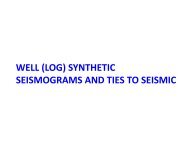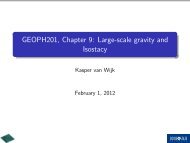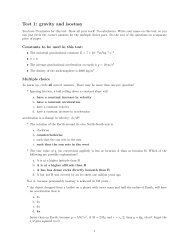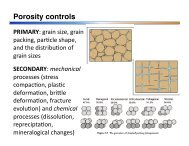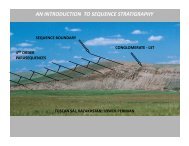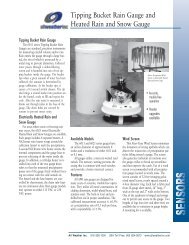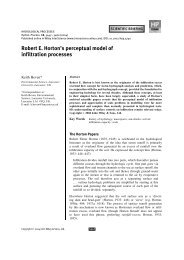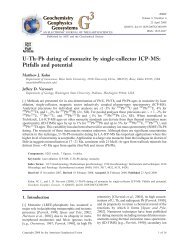Models of diffusion-limited uptake of trace elements in fossils and ...
Models of diffusion-limited uptake of trace elements in fossils and ...
Models of diffusion-limited uptake of trace elements in fossils and ...
You also want an ePaper? Increase the reach of your titles
YUMPU automatically turns print PDFs into web optimized ePapers that Google loves.
Trace element <strong>uptake</strong> <strong>in</strong> <strong>fossils</strong>? 3769<br />
Once a fossil has recrystallized <strong>and</strong> coarsened, <strong>trace</strong><br />
<strong>elements</strong> may be immobile on Myr timescales (Trueman<br />
<strong>and</strong> Tuross, 2002), so <strong>in</strong>tracrystall<strong>in</strong>e <strong>trace</strong> element transport<br />
through the recrystallized apatite must be quite slow.<br />
Rather, transport <strong>of</strong> a <strong>trace</strong> element from the surface to<br />
the recrystallization front probably occurs through an<br />
<strong>in</strong>terstitial aqueous medium, tak<strong>in</strong>g advantage <strong>of</strong> a fossil’s<br />
porosity, even after recrystallization. The concentration<br />
<strong>of</strong> <strong>trace</strong> <strong>elements</strong> <strong>in</strong> the fluid is small compared to<br />
the recrystallized material, <strong>and</strong> <strong>diffusion</strong> rates <strong>of</strong> aqueous<br />
species are quite high. Even account<strong>in</strong>g for the lowest<br />
likely porosities <strong>of</strong> a few percent, the diffusivity <strong>of</strong> the<br />
<strong>trace</strong> element, D, is much larger than the rate <strong>of</strong> movement<br />
<strong>of</strong> the recrystallization front. These considerations<br />
yield a small composition gradient through the recrystallized<br />
material (plus <strong>in</strong>terstial fluids), <strong>and</strong> a sharp composition<br />
front co<strong>in</strong>cid<strong>in</strong>g with the recrystallization front<br />
(Fig. 1).<br />
The <strong>trace</strong> element concentration at the outer surface <strong>of</strong><br />
the material (solid plus <strong>in</strong>terstitial fluid) can be assigned a<br />
value <strong>of</strong> C 1 (a constant) <strong>and</strong> the concentration at the front<br />
(at position x) is C x (also constant); the concentration <strong>in</strong> the<br />
prist<strong>in</strong>e material is assumed to be 0. This relation allows<br />
solution <strong>of</strong> a secondary function (g) <strong>of</strong>k, based on Eq.<br />
13.18 <strong>of</strong> Crank (1975):<br />
gðk=2D 1=2 Þ¼ðC 1 C x Þ=C x ðA:2Þ<br />
where D * is the effective <strong>diffusion</strong> coefficient <strong>of</strong> the <strong>trace</strong> element<br />
through the recrystallized material. Assum<strong>in</strong>g <strong>diffusion</strong><br />
through a porous medium, D * is given by:<br />
D ¼ D U=ðK d s 2 Þ<br />
ðA:3Þ<br />
where D is the <strong>diffusion</strong> rate <strong>in</strong> water, K d is the partition<br />
coefficient between phosphate <strong>and</strong> water, U is porosity,<br />
<strong>and</strong> s is tortuosity. D * differs from D eff <strong>in</strong> account<strong>in</strong>g explicitly<br />
for porosity <strong>and</strong> tortuosity. Whereas K d does affect the<br />
rate <strong>of</strong> movement <strong>of</strong> the recrystalliz<strong>in</strong>g front, it does not affect<br />
the composition gradient through the recrystallized<br />
material, given by (C 1 C x )/C x <strong>and</strong> controlled by the <strong>diffusion</strong><br />
rate <strong>in</strong> the fluid (D).<br />
Because D is large <strong>in</strong> the fluid, composition gradients are<br />
small <strong>and</strong> g(k/2D * 1/2 ) approaches 0, imply<strong>in</strong>g that k/2D * 1/2<br />
also approaches 0 (Fig. 13.6 <strong>of</strong> Crank, 1975). In the limit,<br />
Eq. 13.13 from Crank (1975) reduces to:<br />
gðk=2D 1=2 Þpk 2 =8D <br />
ðA:4Þ<br />
Thus, for expected conditions dur<strong>in</strong>g fossilization, comb<strong>in</strong>ation<br />
<strong>of</strong> Eqs. (A.2) <strong>and</strong> (A.4) gives:<br />
k f½ðC 1 C x Þ=C x Š½8D =pŠg 1=2 ðA:5Þ<br />
Substitut<strong>in</strong>g <strong>in</strong>to Eq. (A.1) <strong>and</strong> squar<strong>in</strong>g yields l<strong>in</strong>earity<br />
between X 2 <strong>and</strong> Dt:<br />
X 2 ¼½ðC 1 C x Þ=C x Š½8D =pŠt ðA:6Þ<br />
APPENDIX A. SUPPLEMENTARY DATA<br />
Supplementary data associated with this article can be<br />
found, <strong>in</strong> the onl<strong>in</strong>e version, at doi:10.1016/j.gca.2008.<br />
05.045.<br />
REFERENCES<br />
Ayliffe L. K., Chivas A. R. <strong>and</strong> Leakey M. G. (1994) The retention<br />
<strong>of</strong> primary oxygen isotope compositions <strong>of</strong> fossil elephant<br />
skeletal phosphate. Geochim. Cosmochim. Acta 58(23), 5291–<br />
5298.<br />
Berna F., Matthews A. <strong>and</strong> We<strong>in</strong>er S. (2004) Solubilities <strong>of</strong> bone<br />
m<strong>in</strong>eral from archaeological sites: the recrystallization w<strong>in</strong>dow.<br />
J. Archaeol. Sci. 31, 867–882.<br />
Briggs D. E. G. <strong>and</strong> Kear A. J. (1993) Fossilization <strong>of</strong> s<strong>of</strong>t tissue <strong>in</strong><br />
the laboratory. Science 259, 1439–1442.<br />
Cherniak D. J. (2000) Rare earth element <strong>diffusion</strong> <strong>in</strong> apatite.<br />
Geochim. Cosmochim. Acta 64, 3871–3885.<br />
Crank J. (1975) The Mathematics <strong>of</strong> Diffusion. Oxford University<br />
Press.<br />
Driessens F. C. M. <strong>and</strong> Verbeeck R. M. H. (1990) Biom<strong>in</strong>erals.<br />
CRC Press.<br />
Egg<strong>in</strong>s S. M., Grun R., Pike A. W. G., Shelley M. <strong>and</strong> Taylor E.<br />
M. (2003) 238 U, 232 Th pr<strong>of</strong>il<strong>in</strong>g <strong>and</strong> U-series isotope analysis <strong>of</strong><br />
fossil teeth by laser ablation-ICPMS. Quaternary Sci. Rev. 22,<br />
1373–1382.<br />
Elderfield H. <strong>and</strong> Pagett R. (1986) Rare earth <strong>elements</strong> <strong>in</strong><br />
ichthyoliths: variations with redox conditions <strong>and</strong> depositional<br />
environment. Sci. Total Environ. 49, 175–197.<br />
Elliott J. C. (2002) Calcium phosphate biom<strong>in</strong>erals. Rev. M<strong>in</strong>eral.<br />
Geochem. 48, 427–453.<br />
Eppell S. J., Tong W., Katz J. L., Kuhn L. <strong>and</strong> Glimcher M.<br />
L. (2001) Shape <strong>and</strong> size <strong>of</strong> isolated bone m<strong>in</strong>eralites<br />
measured us<strong>in</strong>g atomic force microscopy. J. Orthop. Res.<br />
19, 1027–1034.<br />
Grün R. <strong>and</strong> McDermott F. (1994) Open system modell<strong>in</strong>g for U-<br />
series <strong>and</strong> ESR dat<strong>in</strong>g <strong>of</strong> teeth. Quaternary Sci. Rev. 12, 121–<br />
125.<br />
Grün R., Beaumont P., Tobias P. V. <strong>and</strong> Egg<strong>in</strong>s S. M. (2003) On<br />
the age <strong>of</strong> Border Cave 5 human m<strong>and</strong>ible. J. Human Evol. 45,<br />
155–167.<br />
Hart, W. K. <strong>and</strong> Brueseke, M. E. (1999) Analysis <strong>and</strong> dat<strong>in</strong>g <strong>of</strong><br />
volcanic horizons from Hagerman Fossil Beds National Monument<br />
<strong>and</strong> a revised <strong>in</strong>terpretation <strong>of</strong> eastern Glenns Ferry<br />
Formation chronostratigraphy. National Park Service, unpublished<br />
report.<br />
Henderson P., Marlow C. A., Molleson T. I. <strong>and</strong> Williams C. T.<br />
(1983) Patterns <strong>of</strong> chemical change dur<strong>in</strong>g bone fossilization.<br />
Nature 306, 358–360.<br />
Janssens K., V<strong>in</strong>cze L., Vekemans B., Williams C. T., Radtke M.,<br />
Haller M. <strong>and</strong> Knochel A. (1999) The non-destructive determ<strong>in</strong>ation<br />
<strong>of</strong> REE <strong>in</strong> fossilized bone us<strong>in</strong>g synchrotron radiation<br />
<strong>in</strong>duced K-l<strong>in</strong>e X-ray micr<strong>of</strong>luorescence analysis. Fresenius J.<br />
Anal. Chem. 363, 413–420.<br />
Jefferson G. T., McDonald H. G., Akersten W. A. <strong>and</strong> Miller S. J.<br />
(2002) Catalogue <strong>of</strong> late pleistocene <strong>and</strong> holocene fossil<br />
vertebrates from Idaho. In And whereas...papers Whereas...Papers<br />
on the vertebrate paleontology Vertebrate Paleontology <strong>of</strong><br />
Idaho honor<strong>in</strong>g Honor<strong>in</strong>g John A. White, v. 2, Vol. 2 (eds. W. A.<br />
Akersten, M. A. Thompson, D. J. Meldrum, R. A. Rapp <strong>and</strong><br />
H. G. McDonald). Idaho Museum <strong>of</strong> Natural History, pp. 157–<br />
192.<br />
Koeppenkastrop D. <strong>and</strong> De Carlo E. H. (1992) Sorption <strong>of</strong> rareearth<br />
<strong>elements</strong> from seawater onto synthetic m<strong>in</strong>eral particles:<br />
an experimental approach. Chem. Geol. 95, 251–263.<br />
Kohn M. J. <strong>and</strong> Cerl<strong>in</strong>g T. E. (2002) Stable isotope compositions<br />
<strong>of</strong> biological apatite. Rev. M<strong>in</strong>eral. Geochem. 48,<br />
455–488.<br />
Kohn M. J. <strong>and</strong> Law J. M. (2006) Stable isotope chemistry <strong>of</strong> fossil<br />
bone as a new paleoclimate <strong>in</strong>dicator. Geochim. Cosmochim.<br />
Acta 70, 931–946.



